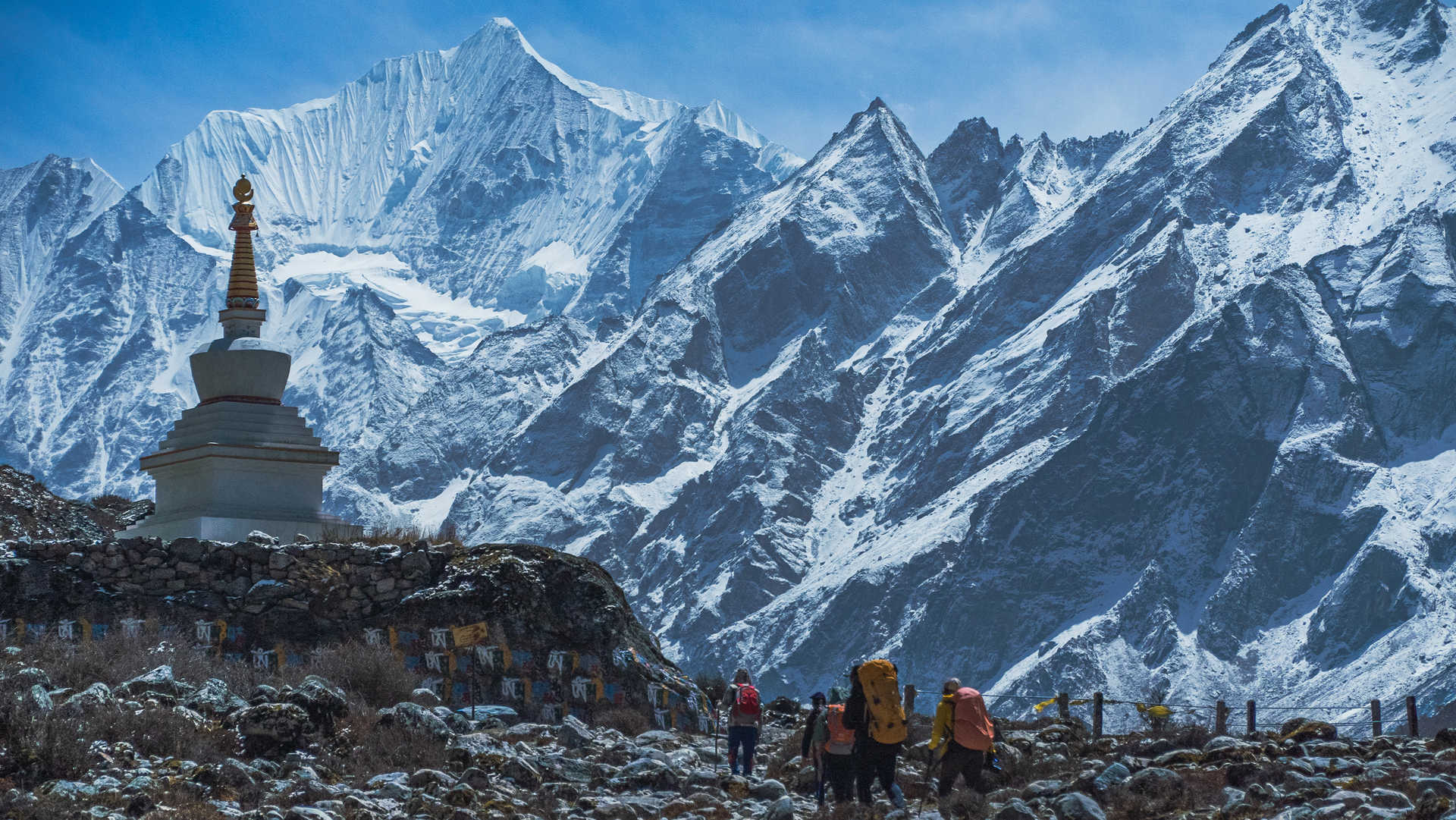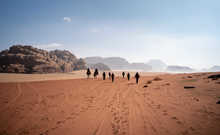The Langtang Valley
- Kandoo Trekking

Contact
our UK team

All trekkers need to organise their own flights to Kathmandu International Airport (KTM). From Kathmandu Airport we will arrange a private transfer to your hotel. That night you will meet your local Kandoo representative and have a full pre-trek briefing.
From Kathmandu, we take a long (approx. 8 hours) drive to Syabru Besi. After driving for 30km, we approach pristine villages on the banks of the river Trishuli. We also start to get views of the Annapurnas, Manaslu, Ganesh Himal and the peaks of the Langtang region.
Today we start our trek by traversing the ridge on Syabru Besi's main road and soon reach Ghopcha Khola. Terraced fields and dense forest with a variety of plant species like oaks, maple, alder and bamboo open up. We may get to see yellow-throated martin, wild boar, langur monkey, red panda and Himalayan black bear en route. Further on, the trail crosses a stream and we pass several small bhattis (tea shops) along the way. As we continue ascending steeply along the trail, we come across a steel suspension bridge at 2000m where we will cross to the north bank of the Langtang Khola amid the spectacular vistas of cascading waterfalls. On reaching 2748 metres, we arrive at Lama Hotel where we will spend the night.
From Lama Hotel, we ascend above the Langtang Khola where the trail becomes steeper. From here we can see the beautiful Langtang Lirung rising up to 7246m. The trail takes us across a log bridge and on to the meadows of Ghora Tabela at 3000m. We will see several lodges and a police check post. Further on, the route opens up into a wide valley of yak pastures and scattered Tamang villages with water-driven mills and prayer wheels. We arrive at Langtang village (3500m) which is headquarters for Langtang National Park. The village mainly consists of flat-roofed Tibetan style houses, hotels and cultivated lands yielding buckwheat, potatoes, wheat, turnips and barley.
Today, the trail skirts gradually through rich yak pastures and interesting traditional villages of Muna and Singdun. We cross a wooden cantilever bridge and reach a wide valley after climbing across the glacial moraine. Finally, we climb up through the mountain pass to reach Kyangjin Gompa where there is a small monastery and a cheese factory.
The furthest point of our trek, we will spend the day in Kyangjin where you will get the opportunity to explore the ancient monastery and cheese factory and just generally soak up the atmosphere. If you are feeling strong you can choose to climb Kyangjin Ri (4600m) from where you will get amazing views of the snow-capped peaks and glaciers.
From Kyangjin, we take the route back to Lama Hotel. As we retrace our steps, we follow the Langtang Khola to Langtang village and on to Ghora Tabela. We stop briefly for lunch and thereafter continue the steep descent to Lama Hotel.
From Lama Hotel, we head back to Syabru Besi where we will have the opportunity to get an insight into the ancient culture and customs of the Tamang community. To celebrate our final night, we have dinner altogether this evening as a full team, it is customary for guests to buy dinner for the porters and guides on this night as a thank you for the support they have given you throughout the trek. There will also be an opportunity for you to hand out your tips for the support team during this meal.
Today we will drive back to Kathmandu. You stay overnight in a hotel in Kathmandu.
We will collect you from your hotel and transfer you to Kathmandu Airport for your departing flight.
The teahouses in the Langtang Valley these days all offer a wide range of options from local Dhal Bhat (rice and lentil soup) to pasta, pizza and even chicken burgers and yak steaks. The menu will always feature something that takes your fancy regardless of your dietary requirements or preferences. We recommend a budget of £30 to £35 ($40 to $45) per day for meals and drinks. For examples of menus visit our Nepal Trekking Guide.
One word of advice, place your meal order as soon as you can upon arriving at the lodge as it is strictly ‘first ordered, first served’, and the best lodges are quite busy at meal times.
Trekking in Nepal is more popular than ever. As a result, the standard of accommodation available on most of the trek routes has improved dramatically. Where there were once simple peasant huts, large hostels have been built featuring running water, indoor toilets (some en-suite) and electricity. However, while internet access, charging facilities and hot water are available, you will need to pay to use them - if you plan on using the internet and showering every day, then you should budget around $10 per day.
However, development is still ongoing, and as you get higher into the mountains the lodges become more basic. Furnishing is generally fairly spartan, and most rooms feature little more than a bench bed and a thin mattress, so your sleeping kit will probably see some early use. Showers are not always available and it tends to be just the communal areas that are heated.
The general standard of driving
throughout Nepal is poor and badly regulated. Roads in Kathmandu are very
congested, many drivers are not properly licensed and vehicles are poorly
maintained. During the monsoon season (June to September) many roads outside
the Kathmandu valley are prone to landslides and may become impassable.
We insist on using a high standard of
vehicle and driver for all of our transfers. In Nepal it is not a legal
requirement to have seatbelts fitted in the back of vehicles, and while we try
to use vehicles that do have rear seatbelts fitted, this cannot always be
guaranteed. If you are unhappy about any aspect of the vehicle or the standard
of driving, please speak to the driver or our local office immediately.
Duffel bags
You will be provided with a large duffel bag at the pre-trek briefing that will be yours to use for the duration of your trek. Your equipment will then need to be transferred into this bag. If you are travelling with a duffel bag then it is up to you which bag you choose to use for the trek, if you are travelling with a suitcase then this will need to be left at the pre-trek hotel and collected upon your return as our porters need the bags they carry to be flexible.
All items must be packed in your main
equipment bag. They should not be attached to the outside, as we are not
responsible if items fall off when the bags are being carried on the trek.
We recommend that you take local currency on the actual trek
with you, as the teahouses prefer local currency. You will also get a more
favourable exchange rate in Kathmandu than in the mountains. If you are relying
on a credit or debit card for emergency funds, make sure you tell your card
issuer that you will be using it abroad, or you may find that it won't work
when you really need it.
In Kathmandu a meal for two at a mid range restaurant will
cost ~$20. A taxi will generally start on a base rate of $0.45 and then charge
$0.4 for every km. Or you can ride the bus which will be around $0.15 for a 5km
journey. Souvenirs in Kathmandu are generally on the cheaper side too. Whilst on the trek, we recommend that you budget £30 - £35
($40 to $45) per day for meals and drinks.
We realise that tipping may not be a common practice in all
countries but for Nepal it is a standard practice that all operators
support. The decision on how much to tip should be determined by how well the
team served you while you were on the trek. Tips are always discretionary and
if you are not happy with the service you have received you do not have to pay
tips. Tips can be made in US dollars or Nepali Rupees. It is very important
that US bills be new (less than 10 years old), crisp and untorn.
We are members of the Trekking Agencies Association of Nepal
and the Nepal Mountaineering Association, and follow their guidelines when
recommending tip levels for guides and porters. We would suggest you budget
$150 per trekker for your tip contribution on this route. The group tip can be
given to your porters and guides during your celebratory meal in Syabru Besi on the
final night of your trek. You will then say goodbye to your porters the
following morning.
Duffel bags
You will be provided with a large duffel bag at the pre-trek briefing that will be yours to use for the duration of your trek. Your equipment will then need to be transferred into this bag. If you are travelling with a duffel bag then it is up to you which bag you choose to use for the trek, if you are travelling with a suitcase then this will need to be left at the pre-trek hotel and collected upon your return as our porters need the bags they carry to be flexible.
We
do not have other gear available for rental but there are many places
offering gear for rental in Kathmandu and we can recommend a number of places
for you. The quality of rental gear is very variable and it is your
responsibility to check carefully the condition of any item you rent. We
accept no responsibility for the quality of equipment hired. An indication of
the likely rental costs is below.
Most
of the rental shops close around 8pm, so if you are arriving on a late flight
the day before the trek starts there will not be an opportunity for you to
visit a rental store. If you are planning on renting equipment, you need to
make sure you have allowed sufficient time at the beginning of your trip.
All
rental equipment is included in your overall trekking bag weight, so make
sure you have allowed for this when packing your bag at home. A sleeping bag
will weigh around 2kg.
UPPER
BODY
LEGS
FEET
OTHER ACCESSORIES
Want to ask us a question or book a private trip? Don't hesitate to contact us!
Contact us